The Marabou Stork (Leptoptilos crumenifer) is a striking bird species native to sub-Saharan Africa, renowned for its imposing size, distinctive appearance, and intriguing behaviors.
With its bare, pinkish head and neck, long, slender legs, and massive wingspan, the Marabou Stork stands out as one of the giant flying birds in the world.
Often found scavenging around carcasses or in urban areas, these opportunistic feeders are vital in ecosystems as predators and scavengers.
Despite facing conservation challenges, including habitat loss and human-wildlife conflicts, the Marabou Stork continues to thrive in diverse habitats across Africa, captivating the attention of birdwatchers and researchers worldwide. So, stay sharp.
Pick Out Characteristics of Marabou Stork
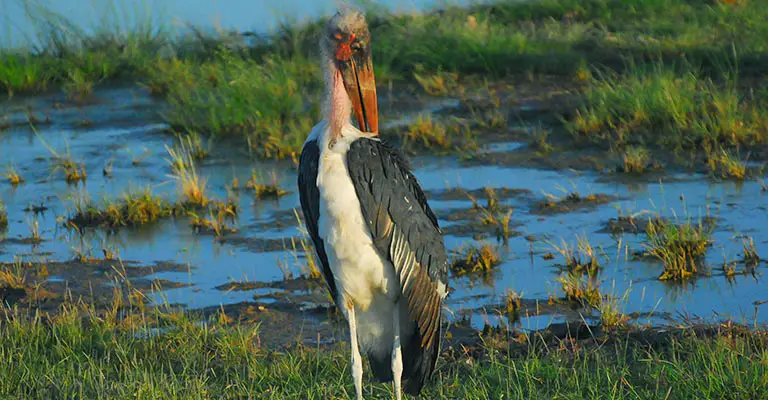
The Marabou Stork (Leptoptilos crumenifer) is a large wading bird native to sub-Saharan Africa.
Known for its distinct appearance and behavior, the Marabou Stork possesses several characteristics that make it easily identifiable:
Large Size
Marabou Storks are among the most giant flying birds in the world, standing up to 5 feet tall with a wingspan of nearly 10 feet. Their size alone sets them apart from other birds in their habitat.
Bare, Pinkish Head and Neck
One of the most striking features of the Marabou Stork is its featherless head and neck, which are wrinkled and pinkish. This bare skin helps prevent feathers from soiling while the bird feeds.
Long, Slender Legs
Marabou Storks have long, thin legs adapted for wading in shallow waters and hunting for prey. Their legs are often greyish or black, contrasting with the lighter plumage on their bodies.
Large, Stout Bill
The Marabou Stork’s bill is large, thick, and slightly curved at the tip, allowing it to grasp and swallow various prey, including fish, insects, amphibians, and small mammals.
White Plumage with Black Wingtips
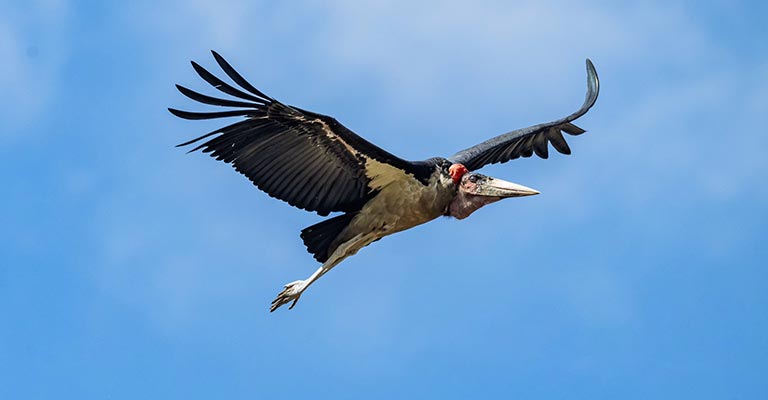
While their bodies are predominantly white, Marabou Storks have black wingtips visible in flight. This black-and-white contrast is distinctive and aids in identification.
Hunched Posture
When standing, Marabou Storks often have a hunched posture, with their necks pulled in and their heads tucked close to their bodies.
This posture and their large size and unique appearance help to distinguish them from other birds.
Gregarious Behavior
Marabou Storks are typically found in groups when roosting and foraging for food. These groups can consist of dozens or even hundreds of individuals, making them conspicuous in their habitats.
Scavenging Habits
While Marabou Storks are skilled hunters, they are also opportunistic scavengers, often congregating around carcasses or garbage dumps to feed.
This behavior and their unattractive appearance and foul-smelling droppings have earned them the nickname “undertaker bird.”
To identify a Marabou Stork in the wild, one should carefully look for these distinctive characteristics.
These features combined create a unique profile that makes the Marabou Stork easily recognizable in its natural habitat.
Whether standing in a group at a watering hole or soaring overhead with its distinctive black-and-white wings, the Marabou Stork is a remarkable and unmistakable bird of the African savannas and wetlands.
Taxonomy of Marabou Stork
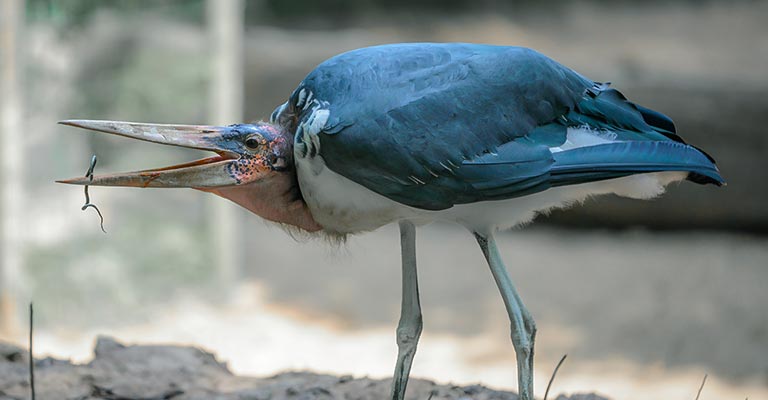
Check out the table for you detailing the taxonomy of the Marabou Stork:
| Domain | Eukaryota |
|---|---|
| Kingdom | Animalia |
| Phylum | Chordata |
| Class | Aves |
| Clade | Aequornithes |
| Order | Ciconiiformes (Bonaparte, 1854) |
| Family | Ciconiidae |
| Genus | Leptoptilos |
| Species | L. crumenifer |
The Marabou Stork (Leptoptilos crucifer) belongs to the family Ciconiidae, which includes large wading birds such as storks, herons, and ibises. Within the family Ciconiidae, the Marabou Stork is classified under the genus Leptoptilos.
Its epithet, crumenifer, derives from Latin, meaning “purse-bearing,” referring to the bird’s distinctive throat pouch for storing food.
The Marabou Stork is further classified under the order Ciconiiformes, which comprises various long-legged aquatic and terrestrial birds.
Taxonomically, the Marabou Stork shares closer ancestry with other storks than herons or ibises due to its morphological and behavioral similarities, such as large size, long legs, and predominantly carnivorous diet.
Reproduction of Marabou Stork
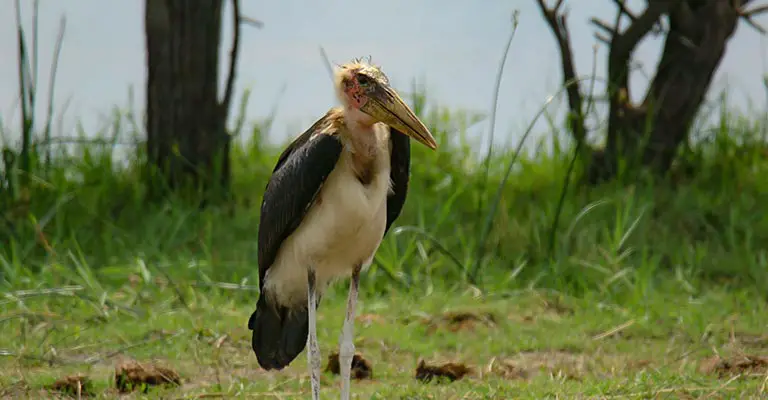
The reproduction process of the Marabou Stork begins with courtship displays, where males engage in elaborate rituals to attract females.
Once a pair has formed, they build a large stick nest in trees or cliffs, often in colonies with other storks. Both parents take turns incubating the clutch of 1-3 eggs for about a month.
After hatching, the chicks are cared for by both parents and proliferate, reaching adulthood within a few months. The parents regurgitate food to feed the chicks until they are old enough to forage.
Marabou Storks typically breed once a year during the dry season when food sources are more abundant, and the young birds fledge after approximately three months, continuing the cycle of life for this iconic African species.
Marabou Stork Life History
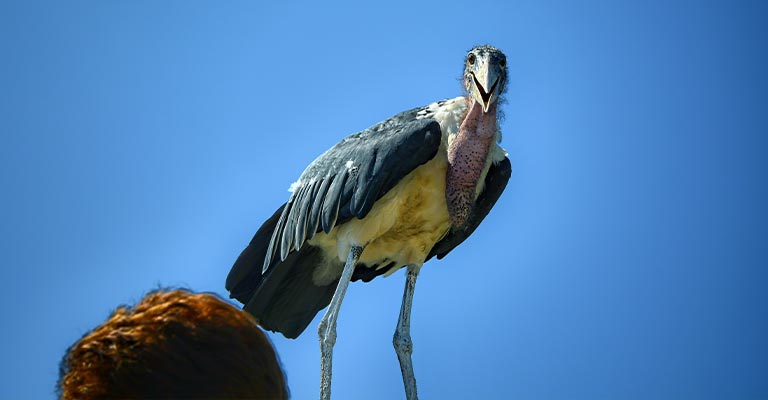
The Marabou Stork (Leptoptilos crumenifer) is a fascinating bird species native to sub-Saharan Africa, renowned for its unique appearance and ecological significance.
Delving into its history reveals a story of adaptation, survival, and the intricate balance between human activities and wildlife conservation efforts.
From its dietary preferences to nesting habits, from habitat preferences to conservation challenges, the life history of the Marabou Stork provides valuable insights into the complexities of avian ecology in Africa.
Food
Marabou Storks are opportunistic feeders with a diverse diet. Their menu includes fish, insects, amphibians, small mammals, and carrion.
They often scavenge around carcasses or human settlements, earning the nickname “undertaker bird.”
Their adaptable feeding habits allow them to thrive in various habitats, from wetlands and riversides to urban areas.
Habitat
Marabou Storks inhabit various environments, including savannas, wetlands, and urban areas. They prefer habitats with access to water, where they can hunt for prey and roost in large colonies.
Their adaptability to human-altered landscapes has led to their presence in urban centers, where they scavenge for food in garbage dumps and along roadsides.
Range Map
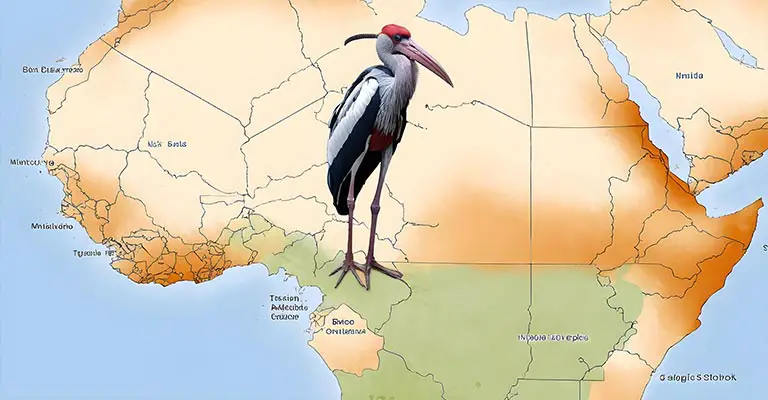
The range of the Marabou Stork encompasses much of sub-Saharan Africa, from Senegal and Ethiopia in the north to South Africa in the south.
They are absent from dense forests but can be found in various open habitats throughout their range.
Nesting Facts
Marabou Storks nest in colonies, often alongside other species of waterbirds, in trees or on cliffs. They build large stick nests, with both parents contributing to nest construction.
Breeding occurs during the dry season when food is more abundant, and pairs typically produce one clutch of 1-3 eggs per year. Both parents share incubation duties and care for the chicks until they fledge.
Diseases and Treatment
Marabou Storks are susceptible to various diseases, including avian botulism, avian influenza, and West Nile virus.
Conservationists and wildlife veterinarians monitor wild populations for signs of disease outbreaks and provide treatment when necessary.
Efforts to mitigate disease transmission include habitat management, vaccination programs, and public education campaigns.
Conservation
The Marabou Stork faces numerous conservation challenges, including habitat loss, pollution, and human-wildlife conflicts.
Conservation efforts focus on habitat preservation, monitoring of breeding colonies, and community engagement to reduce human disturbances.
Additionally, international collaboration is essential for addressing threats like illegal hunting and trade.
The life history of the Marabou Stork reflects its resilience in the face of environmental changes and human activities.
By understanding its dietary habits, habitat preferences, nesting behavior, health concerns, and conservation needs, we can work towards ensuring the long-term survival of this iconic African bird species.
Nesting Habit of Marabou Stork
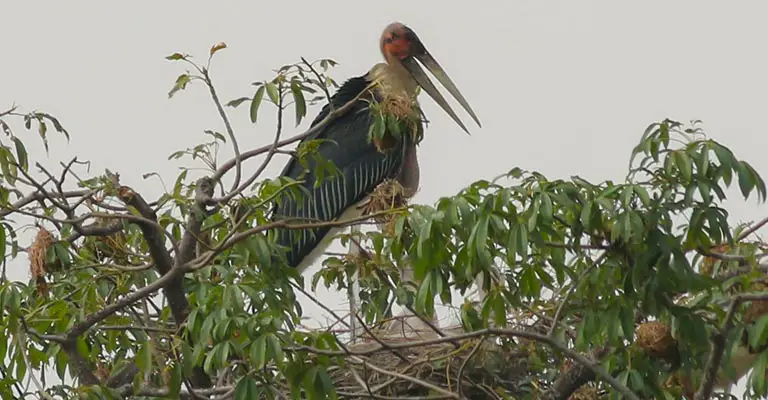
The table below outlines the nesting details of the Marabou Stork:
| Nesting Details | Facts |
| Clutch Size | 1-3 eggs |
| Number of Broods | Large stick nests are built in colonies, often in trees or on cliffs |
| Egg Length | Approximately 8-9 cm |
| Egg Width | Approximately 5-6 cm |
| Incubation Period | Around 30-32 days |
| Nestling Period | Approximately 90 days |
| Egg Description | Cream-colored with a rough texture |
| Nest Construction | Often near water sources for easy access to food |
| Parental Care | Both parents share incubation and feeding duties |
| Nesting Season | Breeding occurs during the dry season when food is abundant |
| Nest Location | Nests may be high in trees or on inaccessible cliffs to protect against predators. |
| Colony Size | Colonies can range from a few pairs to hundreds of individuals |
| Protection Measures | Nests may be situated high in trees or on inaccessible cliffs to protect against predators. |
This table provides a comprehensive overview of the nesting habits of Marabou Storks, including information on clutch size, incubation period, nest construction, parental care, and protection measures.
Marabou Storks nest in colonies, often alongside other waterbirds, constructing large stick nests in trees or cliffs.
During the dry season, when food is plentiful, pairs produce clutches of 1-3 cream-colored eggs, which both parents incubate for about 30-32 days.
Upon hatching, chicks are cared for by both parents, with a nestling period lasting approximately 90 days.
Nests are strategically placed near water sources for easy access to food, and colonies can range from a few pairs to hundreds of individuals.
This communal nesting behavior protects predators and facilitates cooperative breeding efforts.
10 Fun Facts About Marabou Stork
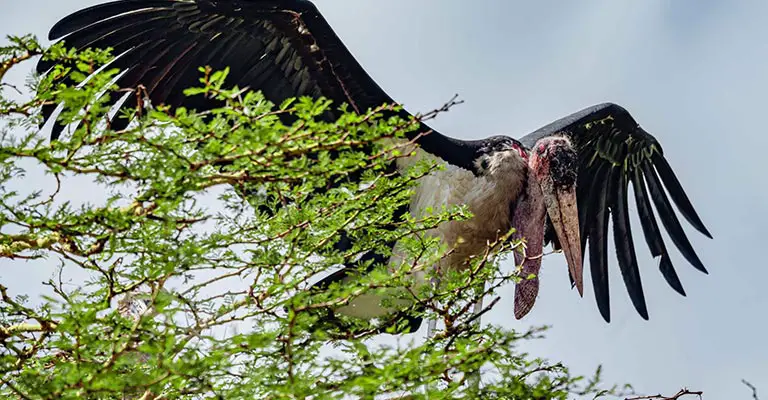
The Marabou Stork is a fascinating bird species native to sub-Saharan Africa, known for its distinctive appearance and intriguing behaviors.
Here are ten fun facts about the Marabou Stork highlighting its unique characteristics and ecological importance.
- Impressive Size: Marabou Storks are among the giant flying birds globally, standing up to 5 feet tall with a wingspan of nearly 10 feet. Their imposing size makes them a sight to behold in their natural habitats.
- Bare-headed Beauty: Unlike many other birds, Marabou Storks have bare heads and necks, which are wrinkled and pinkish. This feature helps prevent feathers from becoming soiled while feeding on carrion.
- Scavenging Specialists: Marabou Storks are renowned scavengers, often congregating around carcasses or human settlements to feed on leftovers. This scavenging behavior earns them the nickname “undertaker bird.”
- Unconventional Nesting: Instead of building nests in isolation, Marabou Storks nest in colonies alongside other waterbirds. These large stick nests can house multiple pairs and protect against predators.
- Diverse Diet: While scavenging is a significant part of their diet, Marabou Storks are opportunistic feeders and will consume a variety of prey, including fish, insects, amphibians, and small mammals.
- Longevity: Marabou Storks have impressive lifespans, with some individuals living up to 25 years in the wild. Their longevity allows them to contribute to breeding colonies over many seasons.
- Efficient Flyers: Despite their large size, Marabou Storks are adept flyers, capable of soaring effortlessly on long-range thermal currents. This skill aids them in their search for food across vast African landscapes.
- Unique Courtship Displays: During the breeding season, male Marabou Storks display elaborate courtship to attract females. These displays involve various rituals, including bill clattering and exaggerated movements.
- Vocal Communicators: Marabou Storks are not particularly vocal birds, but they produce a range of guttural grunts and croaks, especially during interactions at nesting colonies or while feeding.
- Conservation Concerns: Despite their adaptability, Marabou Storks face conservation challenges, including habitat loss, pollution, and human-wildlife conflicts. Conservation efforts are crucial to ensuring the long-term survival of this iconic African species.
These fun facts about the Marabou Stork highlight its remarkable adaptations, behaviors, and ecological significance in the diverse ecosystems of sub-Saharan Africa.
Wrapping Up
So, the Marabou Stork is a remarkable bird species with many fascinating traits and behaviors.
From its imposing size and scavenging habits to its communal nesting colonies and impressive longevity, the Marabou Stork captures the imagination of bird enthusiasts and conservationists alike.
As we continue to learn more about these iconic birds and work towards their conservation, we must appreciate their vital role in African ecosystems and the interconnectedness of all living organisms. Thank you very much.